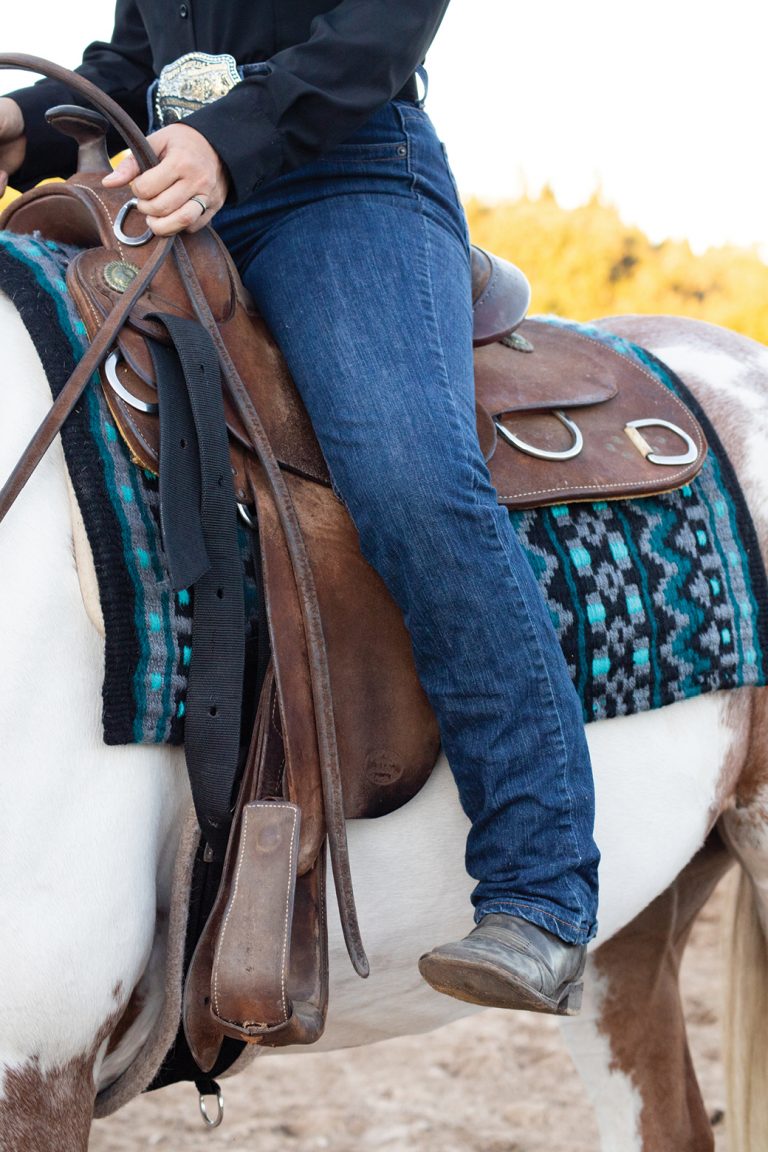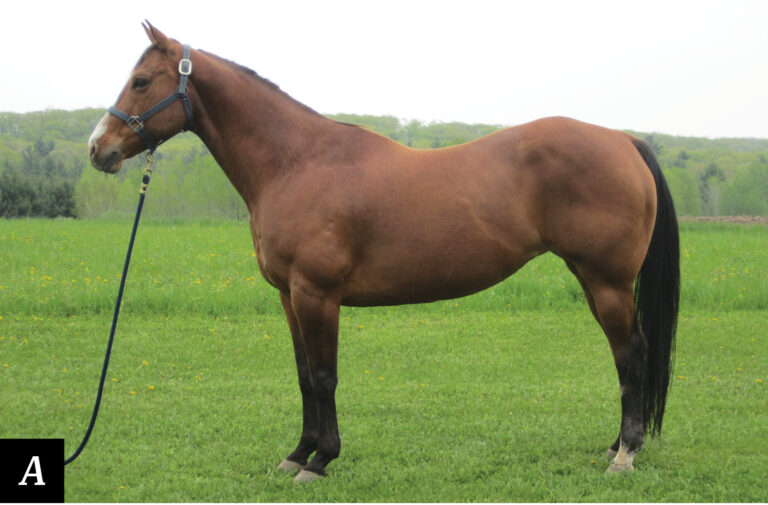I was recently asked to evaluate a set of radiographs for a client purchasing a (very expensive) horse. “Everything is great,” the seller had told her.
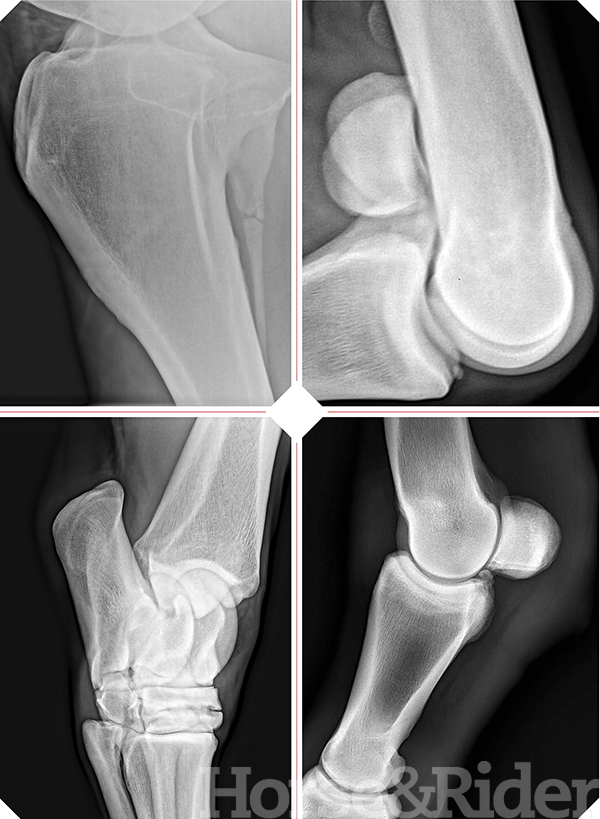
Needless to say, she and I were both surprised to see a large bone fragment right in the middle of the horse’s hock. Was the horse OK? Maybe. Did my client want to take the risk with her hard-earned cash? No way.
So why did the seller and her veterinarian think that chip was “no big deal,” yet my client and I felt differently? Radiographic findings aren’t always 100-percent accurate or predictable, and depending on whether you’re the seller, buyer, or simply an owner trying to make a decision about your horse’s future, your perspective might be different.
In this article, I’ll explain why radiographs aren’t as black and white as they might seem. I’ll start by explaining factors that make it difficult to determine whether something we think we see on radiographs is really there, and how we can determine if it’s real. Then, I’ll detail why even something real might not be all that significant. Finally, I’ll offer real-life examples to help you understand why a finding on a radiograph might seem insignificant in one situation, and important in another.
Is It Real? Or Is It…
The first thing your veterinarian asks when she sees something questionable on a radiograph is “is it real, or is it just an artifact?” An artifact is something that appears on the image, but doesn’t really correspond with the underlying anatomy. In some situations, an artifact can be something that’s really there, like a speck of dirt on your horse’s hair or a small piece of a horseshoe nail. Depending on the location, these types of things can easily be mistaken for a bone fragment or calcified soft tissue. In others cases, an artifact is more an error in perception, such as an overlapping line that appears between two bones that could be mistaken for a fracture. Finally, artifacts can be the result of equipment malfunction—such as a “ghost image” that shows up on the screen underlying the current image.
How does your vet identify an artifact? Often, it’s a question of repeating a radiograph after brushing off the skin or repositioning the leg to see if the artifact disappears. If your vet still can’t decide, she might opt to send films to a board-certified radiologist for review. Veterinary radiologists spend years in training, and much of their time reviewing radiographs. They’re highly skilled at reading radiographs. Even surgeons and veterinarians who specialize in lameness rely on radiologists to help decipher questionable findings. Often, a radiologist can explain what your vet is seeing or offer a suggestion to help eliminate the artifact with a unique view or exposure.
Is It the Problem?
Once your veterinarian determines that a radiographic finding is real, she next explores what’s causing a problem. We’ve all seen horses that have a chip in a hock or fetlock, yet stay completely sound for their entire career. How does that happen? Chances are the chip is buried in the soft tissues away from the joint and never causes any damage. This is especially important if that chip gets blamed for your horse’s lameness when it’s really something else, because in that case your treatment isn’t likely to be successful. For example, if your horse strains his suspensory ligament and your vet identifies a bone chip in his fetlock, surgical removal of that chip won’t solve your problem.
In some situations, subtleties in the appearance of the radiograph can help determine whether a finding is significant. For example, if your horse comes up suddenly extremely lame, a bone fragment identified in the radiograph that’s rounded and smooth is likely old and not the source of the sudden lameness. If it’s jagged and fresh-looking, however, there’s a good chance it’s the culprit. If your vet’s unsure, a radiologist’s review of images can help your vet evaluate these subtleties.
In other situations, additional diagnostic tests can help determine the significance of a radiographic abnormality, beginning with a clinical exam and diagnostic blocks. If your horse is lame, your vet probably decided what area to radiograph based on the results of an examination, and blocks can be especially helpful. When your vet blocks your horse, she’ll inject a local anesthetic substance into nerves supplying an area, or directly into a joint or other enclosed structure. If your horse’s lameness disappears when a specific area is blocked, it helps your vet to localize the source of lameness. Let’s take the example of the fetlock chip in the horse with a ligament injury. If that horse continues to be lame after local anesthetic has been injected into his fetlock joint, chances are that chip is not the reason for the lameness. Your vet will continue to investigate. If, however, the block resolves the lameness, the chip might be worthy of more attention.
In other scenarios, the question might be whether a radiographic finding is active or quiet. A radiologist may be able to shed some light on whether something seen on radiographs appears actively inflamed. If it’s still a question, a bone scan can provide the answer. For a bone scan, your horse will have a radioactive substance injected into his bloodstream. Because active inflammation means increased blood flow, an inflamed area will accumulate radioactivity that can be detected with a special camera. For example, if your horse has radiographic evidence of arthritis in his hocks and develops a sudden hind-limb lameness, your vet might question whether the arthritis really is to blame. And because the hind suspensory ligament originates just below the hocks, results or diagnostic blocks of that area can be unclear. Add that hock injections can actually increase the risk of making a suspensory injury worse, and you see that it’s especially important to make an accurate diagnosis. A bone scan can tell you that the hock joints are quiet and unlikely to be causing the lameness. It might even show activity at the origin of the suspensory ligament, confirming that to be the more likely underlying cause of your horse’s lameness.
The take-home message here is just because there’s something on a radiograph, it doesn’t guarantee it’s causing lameness. It’s important to consider all the factors when making a diagnosis—especially if you want your treatment to be successful.
The Crystal Ball
Finally comes the hardest question of all: What does an incidental finding on a radiograph mean for the horse’s future? A number of factors come into play, and so an incidental finding is likely the situation that causes the most disagreement between buyer and seller regarding significance of the issue.
As a general rule, the horse’s age and work history provide the best information you can get about the potential impact of an incidental finding on a radiograph taken of a perfectly sound horse. If you’re considering an older horse that’s in full work and has been performing his job with no unsoundness for years, there’s a good chance he’ll continue to stay sound as long as his demands don’t change. If the horse is young and hasn’t been in work for very long, however, the risks that something might cause a problem in the future will increase.
Let’s go back to our example of the chip in the horse’s fetlock joint. Assume it’s smooth and round—so obviously it’s been there for a while. And the horse is perfectly sound. But he’s only 3 years old. So is the chip a problem? Maybe so, maybe not. The only way to know for sure is to have that chip removed, which not only allows for an accurate assessment of the health of the joint, but also eliminates the potential for the chip to cause a problem moving forward. If that horse were an older, sound performance horse, removing a chip is unlikely to be recommended. If it hasn’t caused a problem yet, there’s a good chance it’s buried in the soft tissues where it’ll never cause an issue.
Of course, a clinical examination and additional diagnostics such as ultrasound, bone scans, or MRI can also give more information about whether an incidental finding on a radiograph is likely to cause problems over time.
Real-Life Examples
Let’s take a look at some radiographs worthy of debate, and see why the answers aren’t always black and white.
Example #1: Fetlock Chip
Is it real? This small chip in the horse’s fetlock joint isn’t an artifact—it’s really there.
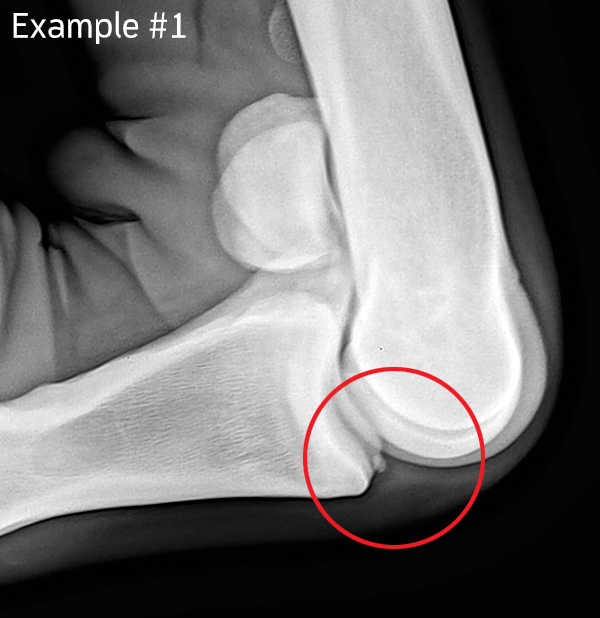
Does it matter? The chip appears round and smooth—it’s most likely been there for a while. If I found it on a horse that was suddenly lame, this chip is unlikely to be the cause. However, it’s in a location where it could cause joint damage over time unless it’s buried in soft tissues where it won’t impact the joint at all.
Can you find out more? Surgical removal would tell you whether the joint has been damaged and prevent the chip from causing damage over time. Most experts will agree that this is the best answer for a young horse. However, if the chip were identified in an older horse that’s completely sound, surgery might be considered risky and unnecessary. Additional radiographic views might show if there are signs of arthritis that could be problematic if they progress, and more advanced diagnostics such as an MRI would give a detailed look at the area.
What’s the true story? This chip was identified on a 2-year-old as part of a set of screening radiographs before the horse was put to work. The chip was removed, the joint looked great, and the horse never looked back.
Example #2: Hock Line
Is it real? This faint line on this horse’s hock could be a hairline fracture. It’s in an unusual location, however, and could also be an artifact caused by overlap.

Does it matter? If this line is a hairline fracture, it’d significantly change the treatment recommendations for this horse. Hock injections to treat his arthritis and continued work could easily lead to a much more serious injury if the fracture blew apart. If it’s just an artifact, this horse’s hocks could be treated with minimal risk.
Can you find out more? A radiologist might be able to determine if this line is just an artifact. If the answer still isn’t clear, a bone scan of the area would show whether this line shows a lot of activity, increasing the chance that it’s a fracture.
What’s the true story? This radiograph was reviewed by several different surgeons and radiologists, and no one could agree whether the line was really significant—especially because the horse had come up suddenly lame and the area was sensitive to touch, which would be unusual for simple hock arthritis. The owner decided against additional diagnostics, and opted to play it safe. He allowed the horse to rest for three months to give time for a possible stress fracture to heal, before treating the arthritis and carefully putting his horse back to work.
Example #3: Fetlock Fragment
Is it real? This bone fragment isn’t an artifact—it is really there.

Does it matter? The fragment is in a location that can be problematic, where it might impact the joint or involve some of the small ligaments that attach in this area. It does appear fairly smooth, indicating it’s most likely been there for a while.
Can you find out more? The age and work history of this horse could be extremely important. If the horse is older, sound, and has a history of successfully working hard, the fragment might be less concerning. If he’s a youngster, risks for future problems would increase. Additional diagnostics such as ultrasound or MRI might offer more about the overall health of the joint and soft tissues in the area.
What’s the true story? This fragment was identified in a sound, older horse working at a very high level. It had first been identified years ago, and radiographs taken six years apart looked identical. Although there’s no guarantee it won’t cause problems in the future, the horse’s history makes it much less of a risk.
Example #4: Fibula Fracture
Is it real? This line looks just like a fracture, but it’s not! It’s a normal finding that occurs when the fibula is developing.
Does it matter? No. Although it looks a bit unusual, this fracture-like line is actually completely normal.
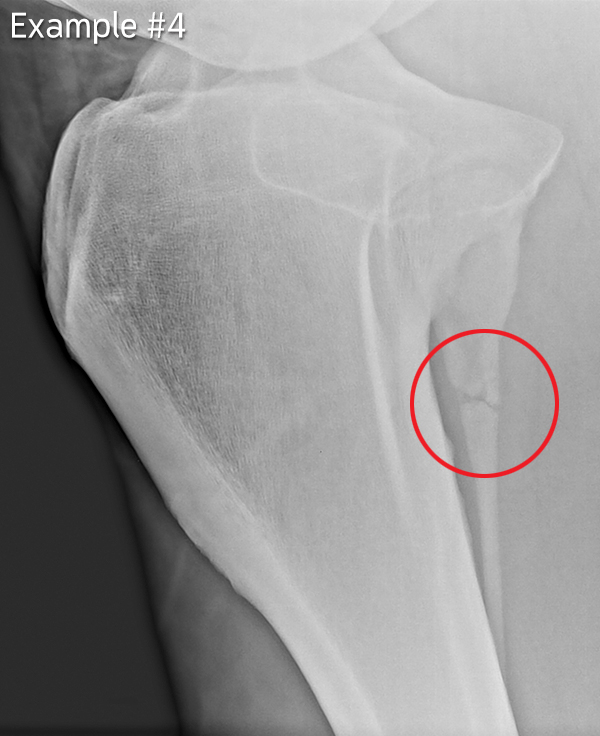
Can you find out more? Sometimes normal variations in anatomy can be confusing, and even your veterinarian might question the significance. A simple way to check is to take a radiograph of the opposite leg to see if it looks the same.
What’s the true story? This horse came up acutely “fracture lame” with swelling in this area of the leg, which caused the vet to question whether this line was really normal, or if the horse had been injured. In the end, the horse had a soft-tissue injury completely unrelated to this radiographic finding.

